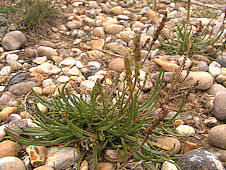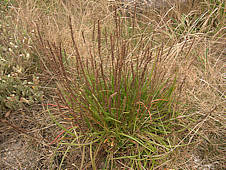|
The Plantaginaceae is a large and diverse family, mostly distributed in temperate climates. There are 90 genera with 1700 species of herbs, shrubs and water plants including Hebe and Veronica. Flowers are usually grouped in a spike or head with 4-merous parts.
|
|
Plantago Linnaeus 1753 (Plantains)
Around 200 species of small herbs. Flowers are carried in long spikes or heads on long stems.
|

 |
Plantago maritima Linnaeus 1753 (Sea Plantain, Goose Tongue)
This perennial plant has a dense basal rosette of thickened, narrow stemless leaves growing 1 - 8 inches long depending on conditions. The inflorescence is a dense spike of small greenish-brown hermaphrodite wind-pollinated flowers with yellowish-brown stamens.
Widely distributed in temperate and Arctic coastal margins in Europe, North-West Africa, Northern and Central Asia, Northern North America, and Southern South America. Across its range there are four subspecies, mostly found on coastal margins and alpine habitats.
This succulent plantain is commonly harvested and the leaves eaten raw or cooked. The muscillage-rich seed can be harvested and used to make flour.
Upper left: Plantago maritima ssp. maritima in shingle on the Chesil Beach, Dorset.
Lower left: Plantago maritima ssp. maritima higher up the beach by the visitor centre.
|

 Families of Succulent Plants
Families of Succulent Plants 





